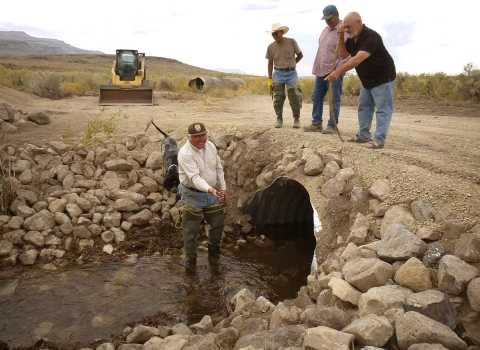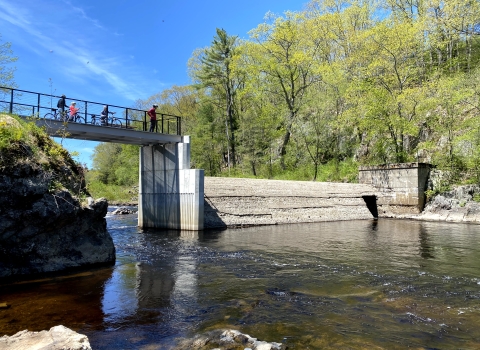The National Fish Passage Program provides financial and technical assistance for projects that improve the ability of fish or other aquatic species to migrate by reconnecting habitat that has been fragmented by a barrier such as a dam or culvert.
What types of technical assistance are available?
We provide financial and technical assistance to support projects that improve community infrastructure resilience, rebuild fish populations, improve recreational and commercial fisheries, and restore the beauty of free-flowing waters. Project proposals may be initiated by any individual, organization, government, or agency, in cooperation with their local Fish and Wildlife Conservation Office. Contact a Fish Passage Coordinator in your area or contact your local Fish and Wildlife Conservation Office to discuss the project and learn more about the technical and financial assistance that is available.
Technical and Planning Assistance: U.S. Fish and Wildlife Service biologists and engineers are available to provide assistance in the planning, design, implementation, and monitoring of select fish passage fish passage
Fish passage is the ability of fish or other aquatic species to move freely throughout their life to find food, reproduce, and complete their natural migration cycles. Millions of barriers to fish passage across the country are fragmenting habitat and leading to species declines. The U.S. Fish and Wildlife Service's National Fish Passage Program is working to reconnect watersheds to benefit both wildlife and people.
Learn more about fish passage projects.
Fish Passage Engineering: Experienced civil and hydraulic engineers working in the fields of fish passage and protection can provide technical assistance in the planning, design, and evaluation of projects to improve conservation outcomes.
Financial Assistance: The National Fish Passage Program provides funding to support fish passage projects. You must work with a Fish and Wildlife Conservation Office biologist to be considered for funding.
How do I apply for funding through the National Fish Passage Program?
You must work with a Fish and Wildlife Conservation Office biologist to be considered for funding. To begin this process, please contact your Regional Fish Passage Coordinator or your local Fish and Wildlife Conservation Office. Service biologists will discuss the project with you and help ensure it is a good fit for the National Fish Passage Program. It is recommended that you do this early in the process so they can help guide the creation of your proposal.
Proposals are accepted year-round; however, the funding cycle for Fish Passage projects begins each year in fall with compilation of the projects being proposed for the following year’s funding. The projects are reviewed and prioritized in winter. Generally, funding for selected projects becomes available the following spring but the timing is dependent upon federal budget allocation. Funding is administered through the regional and local Fish and Wildlife Conservation Offices.
How are projects prioritized?
Proposals will be reviewed by the Fish and Wildlife Service. The following criteria, as well as other criteria dependent on the region, will be used in this process to prioritize projects and make funding decisions.
High priority fish passage projects:
- Show the greatest ecological benefits for trust species
- Exhibit permanence of fish passage benefits
- Make use of the most current scientific knowledge and proven technology
- Evidence the greatest public support, and generate the maximum in matching contributions
What is the average funding level for a fish passage project?
On average the program contributes about $70,000 per project. There is no upper limit to project funding.
Are non-federal matching funds required?
The National Fish Passage Program has flexibility on matching funds from project to project but strives to achieve a 50% match from federal or non-federal sources. This can include in-kind contributions.
Get Started
Fish passage project proposals can be initiated by any individual, organization, government, or agency. However, proposals must be submitted and completed in cooperation with a Fish and Wildlife Conservation Office. (Please note that fish passage projects being used for federal or state compensatory mitigation or required by existing federal or state regulatory programs are not eligible for funding through the National Fish Passage Program. )
CONTACT A FISH PASSAGE COORDINATOR IN YOUR AREA TO GET STARTED.






